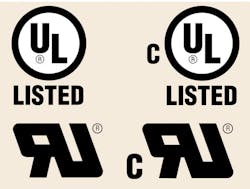For many electricians, it is common practice to look for some form of UL marking on a piece of equipment before installing it. If they see one, they assume everything is okay and proceed with their work. But do you really understand the differences in the variety of UL markings that are out there? Knowing these differences is critical in your work.
From the inception of UL’s Recognized Component program, the use of “Recognized” products has been restricted. Recognized components are to be factory-installed in originally approved equipment. UL Recognized components cannot be field installed. Here’s a quote taken from the UL website:
“Components covered by UL’s Recognized Component program are intended to be installed in another device, system, or end product. They are to be installed at the factory, not in the field, and they may have restricted performance capabilities that limit their use.”
So what exactly is a “Listed” product? UL describes a Listed product as:
“Products bearing the UL Listing mark are usually either complete appliances, or equipment and materials that are intended for installation in accordance with model codes such as the National Electrical Code (NEC). These products have been investigated using applicable construction and performance requirements, and when installed in accordance with the manufacturer’s installation instructions, should provide a safe, code-compliant installation. UL’s ‘Listing’ evaluation of an end product includes an investigation of the construction and performance of all installed components.”
UL helps further explain the difference between a UL Listing and Component Recognition by noting:
“Comparing UL ‘Listing’ and ‘Component Recognition’ is like comparing a car and an engine. A car is a finished product, and an engine is a necessary component. However, not every engine is compatible with every car. The same is true for UL Recognized Components, which will not be compatible with all end-product equipment applications.”
Let’s take a look at a specific product category to further clarify the differences in these two designations.
For example, when it comes to current transformers (CTs), UL 2808 draws clear lines between Listed and Recognized CTs, and how they’re installed. All UL Recognized CTs are tested and verified. Maintenance professionals have commonly installed or replaced UL Recognized CTs. The Recognized marking, however, means that the CT is a component of a specific system. Borrowing the automobile analogy, you may swap a specific model 4-cylinder motor into a same model car, but it may not be right for a 4-cylinder pickup, even though it’s the same make.
Because UL Recognized components are only intended for installation in the equipment they were originally evaluated as a “part-of,” they may include unique construction or they may be restricted in performance capabilities. Those are a few of the reasons UL does not claim they can be safely installed by electricians or contractors in the field.
CT construction aside, these are some examples of controlled conditions that would restrict a CT installation to a specific system:
- Terminals are to be factory wired only, per its original publication.
- Spacing between factory connectors may be specific to an end product.
- Short circuit capability may need to be evaluated in the end-use application.
- Spacing from exposed live metal parts to the enclosure may affect safety.
If a Recognized Component is installed in the field, the only way for UL to verify compliance is to conduct a UL Field Evaluation on the end product. Clearly, this equates to time and money. If you are replacing CTs that were factory installed in a system in a specific location with a file number associating the CT to the system — and they have a logo similar to those shown in Fig. 1 — then you’re doing fine. Otherwise, you should be installing a UL Listed CT.
Investing in UL Listed products allows contractors and maintenance professionals to field install these devices with the confidence that they passed UL’s evaluation criteria. Products with a UL Listing logo (Fig. 2) should include file numbers. UL has made it easy for you to verify the listing of the product you’re using through a searchable database on its website. Simply type in the UL listing number in the database and hit the search button. All of the product specs and testing criteria for that specific product should pop up on your computer screen.
So before your next job, check your inventory to ensure you’re installing the properly designated UL product.
Burwell is the owner of Sentran Corp. in Salem, Ore. He can be reached at [email protected].


